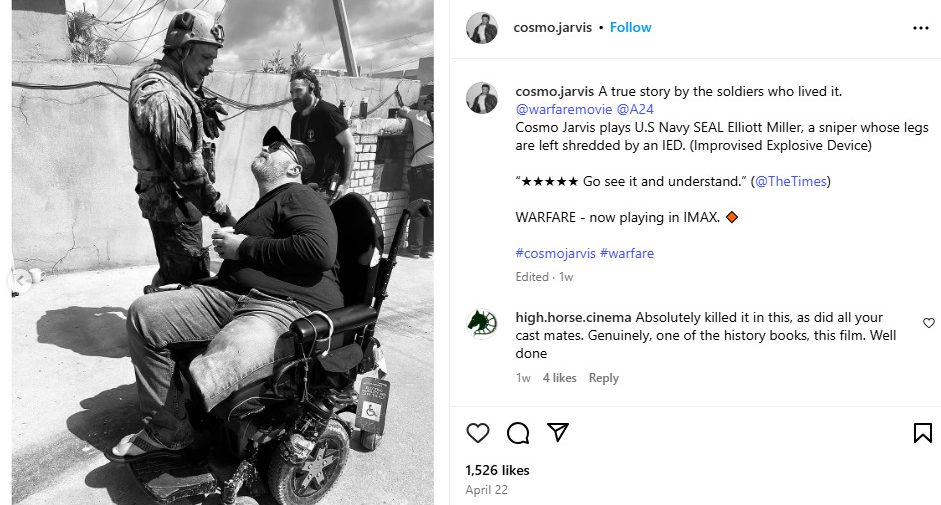Helmed by Ray Mendoza and Alex Garland, ‘Warfare’ is a war drama centering on the events of a single day, November 19, 2006, during the Battle of Ramadi, part of the Iraq War. The film centers on a Navy SEAL unit that has set up base in a local house in Ramadi, a city in central Iraq. While providing surveillance for an operation, the platoon comes under attack from enemy forces and must fight to survive until either help arrives or they get away from the combat zone. The film offers a raw depiction of the horrors the unit underwent, with the visuals serving as a mirror of reality.
Warfare Filming Locations
‘Warfare’ was filmed in England, specifically in Hertfordshire, and in Iraq. Principal photography reportedly began in the second half of May 2024 and continued for over five weeks before wrapping up in the first week of July the same year. While the initial need was to scout Middle Eastern and North African countries to find an area and streets that resembled those where the events took place, Garland told Screen Daily how “…the whole focus on the film was to be as accurate as possible, and so it made more sense for us to build it and get it as right as we possibly could.” However, some scenes were reportedly filmed in Iraq.
Hertfordshire, England
The aim of the production team was to recreate the entire area, especially Ramadi Street, where most of the action takes place. For this, it accessed the space and tech of the Bovingdon Airfield Studios, built on a World War 2 airfield, located near the village of Bovingdon in Hertfordshire. Mendoza himself was a part of the military unit and contributed immensely to the story. Elliott Miller, the unit’s head sniper and medic, was on set too, which added an emotional layer to the production. Talking about filming a particularly intense scene, Mendoza told Entertainment Weekly how “it pulled on that nerve, that heartstring…Elliott started to cry, and then I had to go off set because I didn’t want the actors to see me crying. So I called cut, ran off set, and I cried for a good 10 minutes. And at that point, Alex had to take over the rest of the day.”
For the sake of authenticity, the directors consulted as many soldiers of the platoon as they could track down to reconstruct the action, taking immense care to showcase even the most minor details. Moreover, Google Earth, firsthand accounts of non-American military sources, and photographs of the real house in the aftermath of the “warfare” were also accessed. All these references were used to recreate that house, the surrounding neighborhood, including 13 buildings, and the streets. “We had some documentary evidence that the sniper hole was here on that wall, the color of the curtains was this, this room looked like that, this bloodstain looked like that,” Garland told Entertainment Weekly. “We had something very concrete to build from.”

The actors underwent a three-and-a-half week boot camp, a condensed version of the traditional SEALs program BUD/S (Basic Underwater Demolition/SEAL training). This helped them learn not only about the tactics, weaponry, and safety, but also about brotherhood. “The BootCamp (during filming) was reminiscent of (real) training, exercising together, learning together, doing weapon drills and range packages together, building camaraderie,” former Royal Marine turned actor Aaron Mackenzie told the BBC.
Since the action takes place in 2006, military hardware shipped from the US was retrofitted as per the specifications of the time. The infantry, too, was customized to resemble those used during that period, including the M2 Bradley Fighting Vehicles, seen in the film, which were added with armor plates, gun barrels, and deployable ramps. The aim was not to glorify war but to show it as it is, something the crew successfully achieved by building everything from scratch and capturing almost everything practically. Green and blue screens were used only when necessary, and they were then altered to match and extend backdrops in post-production.
The 100-acre complex at Bovingdon Airfield Studios offers five sound stages with a total area of over 100,000 ft², a 60-acre multi-surface backlot, 12 workshops, two runways, a large production pad, and a wide range of facilities to streamline filming. All this space enabled the crew to experiment as much as possible while keeping the memory-based narrative intact. Furthermore, using space creatively helped the crew ensure the audience gets an immersive viewing experience. The studio has served as the base for movies and shows like ‘Masters of the Air,’ ‘1917,’ ‘Fury,’ and ‘Deadpool & Wolverine.’
Iraq
The crew reportedly taped some additional scenes in Iraq as well. Since the events shown in the film occurred there, shooting on-site naturally adds a whole new layer of realism to the visuals. Needless to say, the grit and dust can be tough to replicate on custom-built sets. Many other war movies, like ‘The Hurt Locker,’ ‘Zero Dark Thirty,’ and ‘Sand Castle,’ were filmed in real locations in the Middle East, in accordance with the backdrops in the narratives.
Read More: Where Was Rust Filmed? Shooting Locations of Alec Baldwin Movie


